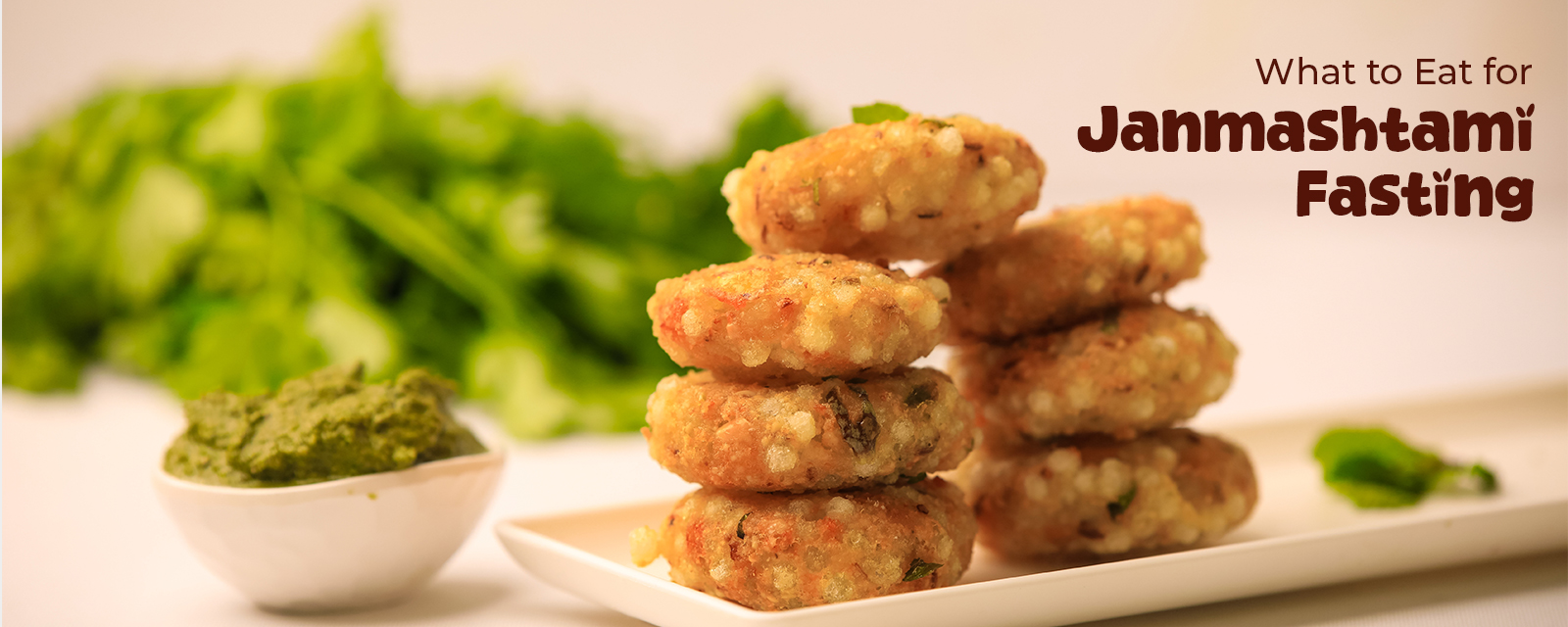
Janmashtami is the joyous celebration of the birth of Lord Krishna, the eighth incarnation of Lord Vishnu, lovingly called Kanhaji.
As one of the main Hindu festivals, Janmashtami is a festival filled with devotion, music, and satvik recipes for vrat.
This year, Krishna Janmashtami is falling on 16 August, 2025, on the Astmi tithi of Krishna Paksha in Bhadrapada.
Along with beautiful decoration for welcoming little Krishna, the kitchens will brim with the aroma of satvik recipes for Janmashtami vrat.
For many devotees of Shri Krishna, Janmashtami isn’t just about abstaining from certain foods but eating pure, satvik foods that are nourishing and permissible during the vrat.
In this blog, we have made a list of 5 Simple Janmashtami vrat recipes that are satvik and easy to make.
What to Eat for Janmashtami Fasting -

In Hinduism, only certain grains, vegetables, and spices are used. This list varies according to every family’s specific traditions, but these are the main grains, vegetables, and spices that are used during fasting.
Why use pesticides in your satvik fast recipes when you can choose from certified organic ingredients for Janmastami from Refreshyourlife.
Flours - Kuttu or buckwheat flour, rajgira or amaranth flour, singhara or water chestnut flour, sama chawal or Barnyard millet, Sabudana or tapioca pearls, and arrowroot flour.
Spices - Sendha namak or rock salt, Anchor or dry mango powder, kali mirch or black pepper powder, jeera powder or cumin seeds, ajwain or carom seeds, elaichi or cardamom, and laung or cloves.
Fruits or Vegetables - Aloo or potato, arbi or colocasia, Sweet potato or shakarkand, Yam or jimikand, Raw banana, lauki or bottle gourd, kaddu or yellow pumpkin, kheera or Cucumber, nimbu or lemon, hari mirch or green chilli, adrak or ginger, bathua ki bhaaji, and Green coriander.
Nuts - All the dry fruits and nuts like cashew, phool makhana, almonds, pistachio, chiroli, raisins, coconut, walnut, peanuts, pine nuts, prunes, pecans, pumpkin seeds, and sunflower seeds.
Fruits - All the fruits, raw or ripe, sweet or sour, are allowed to be used during Janmashtami vrat.
Dairy Products - Milk, Yogurt, Khoya, paneer, cream, malai, butter, ghee, and lassi.
Sweets - All the sweets are made purely with milk, khoya, or paneer, or nuts can be consumed.
Cooking Medium - Ghee, butter, or any cooking oil can be used, but peanut and sunflower oil are used during fasting.
Here are some satvik recipes for Janashtami 2025 you can try:
Sabudana Khichdi Recipe -
Sabudana Khichdi is a light, nutritious, perfect fasting recipe for Janmashtami.
This Maharashtrian favorite is a must-have during vrat or fasting in India. We use organic sabudana here for extra nutrition and taste.
Ingredients (Serves 2)
How to make Sabudana Khichdi for Janmashtami:
How to make Sabudana Khichdi for Janmashtami:
Sama Chawal Khichdi -
Sama chawal or barnyard millet is a wholesome, fiber-rich cereal that is light on your stomach during fasting.
This Krishna Janmashtami vrat recipe makes you feel full and keeps you energized for the midnight Krishna aarti.
Ingredients (Serves 2)
How to Make Sama Chawal Khichdi:
Tips for perfect sama chawal khichdi:
Vrat ke Aloo aur Rajgira ki Puri -
For Krishna Janmashtami fasting, vrat ke aloo with rajgira ki puri are one of the most comforting foods.
Mildly spiced, satvik vrat ke aloo with rajgira (amaranth) ki puri makes a comforting and utterly satisfying phalahar meal.
This combination is often served after offering bhog to Lord Krishna, as it embodies both simplicity and celebration.
Ingredients
For Vrat ke Aloo:
For Rajgira ki Puri:
How to make Vrat ke Aloo:
How to make Rajgira ki Puri:
Tips for Perfect vrat ke aloo and rajgira ki puri:
Singhare ka Halwa -
Singhara or water chestnut flour is an all-time favorite ingredient for fasting, especially Janmastami vrat.
Singhare ka Halwa is a rich, smooth, and warm dessert for your fast, which perfectly pairs with the devotional mood.
You can also offer this halwa as a bhog to Bhagwan Shri Krishna.
Ingredients (Serves 3–4)
How to make Singhare ka aata:
Tips for Perfect Singhare ka Halwa:
Makhane ki Kheer -
When it comes to Janmashtami vrat-friendly desserts, Makhane ki Kheer is a classic recipe.
This creamy, nutty, nutritious recipe is made from Makhana or fox nuts and is often offered as bhog to Bhagwan Shri Krishna.
Ingredients (Serves 3–4)
How to make Makhane ki kheer:
Tips for perfect makhane ki kheer:
FAQ’s -
When to keep fast on Janmashtami 2025?
Janmashtami fast will be observed on August 16, 2025, as per the Udaya Tithi of Ashtami of Krishna paksha in the Hindu month of Bhadrapada.
What can I eat in Janmashtami fast?
Satvik foods like sabudana, sama chawal, rajgira, makhana, singhara atta, fresh fruits, and milk-based dishes are allowed.
How to do Janmashtami fast at home?
Janmashtami fast can be observed in two ways. Either nirjala fast, where devotees abstain from eating till midnight, or falahar fast, where they eat satik meals, offer bhog at midnight, and break the fast after aarti.
What is Lord Krishna's favourite food?
Makhan Mishri, milk sweets, and dishes made from dairy are considered Shri Krishna’s favourites.
What is the time of Bhog for Janmashtami?
Janmashtami bhog is offered during midnight, when Shri Krishna’s birth takes place.
Can I eat prasad during Janmashtami fast?
Yes, you can eat vrat-friendly prasad or bhog offered to Shri Krishna during the Janmashtami vrat.
Read More From Naturopedia
Makhan Mishri: The Science Behind Krishna’s Favorite Sweet
Try this High-Protein Ladoo Recipe for Ultimate Energy Boost Every Day
Rainy Day Cravings? Try These 5 Healthy Indian Monsoon Recipes
How to Read Labels to Spot Genuine Organic Products (And Avoid Fake Organic)
December 26th, 20257-Day Healthy Meal Prep Ideas for Indian Veg Meals (No Hassle!)
December 23rd, 202510 Must-Try Eco-Friendly Products to Replace Plastic at Home
December 17th, 2025